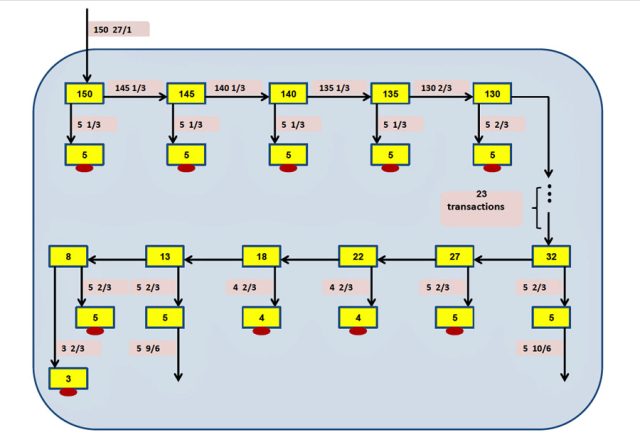
More than three-quarters of the digital coins in the Bitcoin digital currency scheme aren't circulating because they remain dormant in user accounts that have never participated in outgoing transactions, a recently published study has found.
The figure translates to more than 7.019 million BTCs, the term used to denote a single coin under the digital currency, which uses strong cryptography and peer-to-peer networking to enable anonymous payments among parties who don't necessarily know or trust each other. Based on exchange rates listed on Mt.Gox—the most widely used Bitcoin exchange—the coins have a value of more than $82.87 million. On May 13, the date the researchers analyzed their data, there were slightly more than 9 million BTCs in existence.
Mathematician Dorit Ron and Adi Shamir (the "S" in the widely used RSA cryptography scheme) arrived at that finding by downloading the entire Bitcoin history and following the trail of some 180,000 transactions. They found there were about 3.12 million accounts, which are known as "addresses" in Bitcoin parlance. They belonged to about 1.5 different owners, on average, since there's no limit on how many addresses a single individual may possess. More than 609,000 of those addresses had received a significant portion of the outstanding BTCs without once making a payment, the researchers reported.
"However, if we sum up the amounts accumulated at the 609,270 addresses which only receive and never send BTCs, we see that their owners have actually put aside in some kind of 'saving accounts' 7,019,100 BTCs, which are almost 78 percent of all existing BTCs," the researchers wrote. Almost 60 percent of those coins were "old," meaning they were received more than three months prior to the May 13 cut-off date for the project.
"This means that there are much fewer BTCs in circulation than previously presumed," the researchers continued. "Yet, the total number of Bitcoins participating in all the transactions since the establishment of the system (except for the actual minting operations) is 423,287,950 BTCs. This implies that each coin which is in circulation had to be moved a much larger than expected number of times."
The report, titled Quantitative Analysis of the Full Bitcoin Transaction Graph, isn't the first time researchers have analyzed the full available history of Bitcoin transactions. A paper presented earlier this year by Fergal Reid and Martin Harrigan, demonstrated how it's possible to identify some Bitcoin users despite some of the scheme's anonymity features. Research presented at last year's Chaos Computer Club conference also showed how to defeat Bitcoin anonymity. Ron and Shamir's research, by contrast, analyzes transaction history to answer questions about how typical account holders use the Bitcoin system and how they acquire and spend the digital coin.
In addition to discovering that the vast majority of BTCs don't circulate, the new paper also found that almost all large Bitcoin transactions stem from a single payment made almost two years ago. They made that finding despite apparent attempts by the account holders involved to obfuscate their actions. The researchers started by mining the history for data that identified when two or more addresses belonged to the same owner. They then isolated transactions involving 50,000 BTCs or more and analyzed when the amounts were accumulated and spent.
"We discovered that almost all these large transactions were the descendants of a single large transaction involving 90,000 Bitcoins which took place on November 8th 2010, and that the subgraph of these transactions contains many strange looking chains and fork-merge structures, in which a large balance is either transferred within a few hours through hundreds of temporary intermediate accounts, or split into many small amounts which are sent to different accounts only in order to be recombined shortly afterwards into essentially the same amount in a new account.
The discovery that so little of the currency is actually in circulation could have implications for the future of the Bitcoin system. It's unclear what might happen if large amounts of those reserves were to begin trading suddenly. It's a recommended Bitcoin security precaution to keep keep most coins in an offline, "cold storage" wallet, and this results in large pools of reserves that rarely move. Still, it wouldn't be surprising to see such an influx cause a decline in the value of each coin, similar to a 90-percent decline experienced last year.
Article updated to correct average number of address owners in the third paragraph, and to add detail about reserves in the last paragraph.
Listing image by Aurich Lawson / Thinkstock
reader comments
89